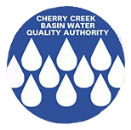Zooplankton
Highlights:
Zooplankton serve as consumers of algae in Cherry Creek Reservoir. In WY 2022, the zooplankton population dynamics were similar to previous years.
Zooplankton are microscopic animals that consume algae and bacteria in the water column. Some types of zooplankton feed on algae, others on other zooplankton, and some take in both plant and animal particles. Larger zooplankton can exert significant grazing pressure on algal cells; however, they are also subject to predation as they are a food source for larger crustaceans, aquatic insects and fish.
Most freshwater zooplankton are part of only three phyla: amphipods, which include both cladocerans (shown in green) and copepods (shown in orange); rotifers (shown in yellow); and protozoa (shown in blue). Cladocerans and copepods are microscopic crustaceans that feed primarily on phytoplankton. These organisms can be an important food source for fish and can also exert grazing pressure on phytoplankton populations when present in high enough numbers. Rotifers are microscopic animals that feed on detritus and smaller organisms, such as bacteria. They can also serve as a food source for larger zooplankton. Protozoans are single-celled organisms that feed on other microorganisms, organic matter, and debris.
The invasive water flea, daphnia lumholtzi, a type of cladoceran, is less palatable to fish due to its spines. This water flea has been frequently identified in Cherry Creek Reservoir every year since 2018 and is often a major contributor to zooplankton biomass (44% in WY 2022). Other than these undesirable species, the Reservoir lacks high numbers of large-bodied cladocerans, which are a priority food source for young fish. Based on the healthy fishery, the low populations of large zooplankton may be due to the predation by the gizzard shad, which are the main food base in Cherry Creek Reservoir.
The zooplankton population in Cherry Creek Reservoir in WY 2022 averaged approximately ten species, which is typical for a Colorado lake. Copepods were typically the zooplankton present in the highest numbers in Cherry Creek Reservoir and accounted for over 50% of the total population throughout the summer months.
Useful Links

Zooplankton Concentrations and Biovolumes
info_outlineEach point on this graph represents a sampling event. The y-axis represents the concentration (number) and the size of the bubble represents the biovolume (size). The colors represent different zooplankton groups. Use the filters to target a specific group or date. To learn more about a specific data point, hover over it with your mouse.
